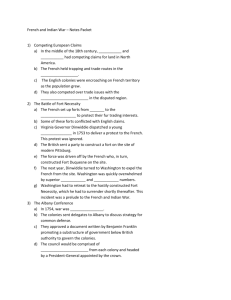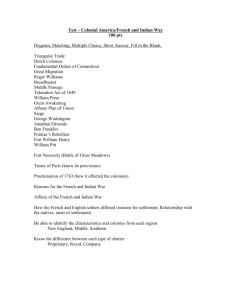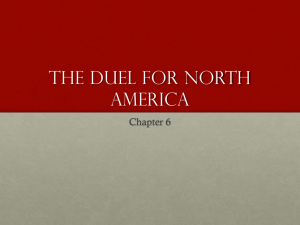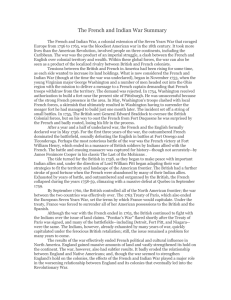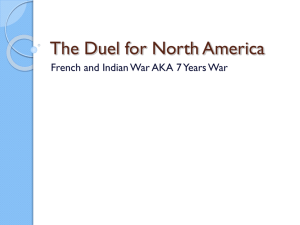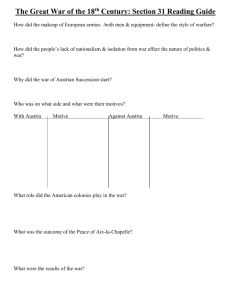French and Indian War
advertisement
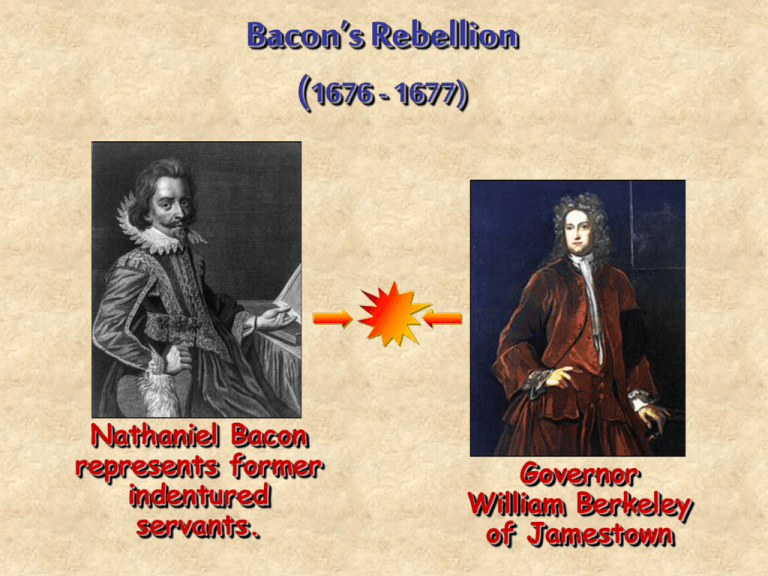
Bacon’s Rebellion (1676 - 1677) Nathaniel Bacon represents former indentured servants. Governor William Berkeley of Jamestown Bacon’s Rebellion (1676 - 1677) Nathaniel Bacon, representa a los antiguos sirvientes. Governor William Berkeley of Jamestown •Involved former indentured servants •Not accepted in Jamestown •Disenfranchised and unable to receive their land •Gov. Berkeley would not defend settlements from Indian attacks •Involucrados ex funcionarios contratados •No se aceptan en Jamestown •Disenfranchised y no puede recibir su tierra •El gobernador Berkeley no defendería los asentamientos de ataques de los indios •Nathaniel Bacon acts as the representative for rebels •Gov. Berkeley refused to meet their conditions and erupts into a civil war. •Bacon dies, Gov. Berkeley puts down rebellion and several rebels are hung Consequence of Bacon’s Rebellion Plantation owners gradually replaced indentured servants with African slaves because it was seen as a better investment in the long term than indentured servitude. •Nathaniel Bacon, actúa como representante de los rebeldes El gobernador Berkeley negó a cumplir sus condiciones y estalla en una guerra civil. Tocino muere, el gobernador Berkeley pone la rebelión y varios rebeldes se cuelgan Consequence of Bacon’s Rebellion . Los dueños de plantaciones reemplazados gradualmente sirvientes con los esclavos africanos, ya que fue visto como una mejor inversión a largo plazo que la servidumbre By Coach Ketcham Life in the French Colonies In most of the French colonies, the tendency was for the settlers to merge their culture with the Indians. In this drawing, white settlers and Indians relaxed together at Vincennes, a French settlement established in the 1720s in what would be later known as the state of Indiana. 8 Life in the French Colonies En la mayor parte de las colonias francesas, la tendencia era que los colonos para combinar su cultura con los indios. En este dibujo, los colonos blancos y los indios se relajaron junto al Vincennes, una colonia francesa establecida en la década de 1720, en lo que sería más tarde conocido como el estado de Indiana. 9 Differences between French and British colonies New France was more than double the size of British Colonies, yet much less populated British more interested in bringing settlers in from the mother country, French more interested in making Native Americans French citizens. They tended to treat Indians as equals and intermarried. French more interested in exploiting new lands economically French tended to develop stronger alliances 10 with Indians Differences between French and British colonies Nueva Francia fue más del doble del tamaño de las colonias británicas, sin embargo, mucho menos poblada Británica más interesados en traer colonos de la metrópoli francesa, más interesados en la toma de los nativos americanos a los ciudadanos franceses. Ellos tienden a tratar a los indios como iguales y se casaron. Francés más interesados en la explotación de nuevas tierras económicamente Francés tiende a desarrollar alianzas más fuertes con los indios 11 The French and Indian War 1754-1763 Disputed land claims in Western Pennsylvania in 1754 brought two of the greatest world powers to a conflict that spread in both the New World and in Europe. 12 The French and Indian War 1754-1763 Las reivindicaciones de tierras en disputa en el oeste de Pennsylvania en 1754 trajo dos de las mayores potencias del mundo a un conflicto que se extendió tanto en el Nuevo Mundo y en Europa. 13 French and Indian War: Alliances Alliance - a formal agreement by two or more nations to act together in a cause • France, Spain (1762), Algonquins, and Hurons versus • Great Britain and the Iroquois French and Indian War: Alliances Alliance - un acuerdo formal entre dos o más naciones a actuar juntos en una causa • France, Spain (1762), Algonquins, and Hurons versus • Great Britain and the Iroquois single click speaker to hear audio clip >>>>> Causes • Conflicting claims over vast territories • Control over St. Lawrence, Great Lakes, Mississippi and Gulf waterways. • Religious differences – French Catholics vs. British and Protestants • Control over lucrative beaver trade • Grand Banks fishing rights • Seething tension from prior wars single click speaker to hear audio clip >>>>> Causes • Afirmaciones contradictorias? Más vastos territorios -El control sobre St. Lawrence,? Grandes Lagos, el Mississippi? Y cursos de agua del Golfo. -Las diferencias religiosas -? Católicos franceses contra británicos y protestantes? -El control de la lucrativa? Comercio castor -Grandes Bancos derechos de pesca -Tensión hirviente de las guerras anteriores Territorial Claims • French explorers sent to make claims • French expeditions sent to remove English settlers and build forts • Forts became key focal points during the conflict Territorial Claims • Exploradores francés? Enviado a hacer afirmaciones -Expediciones francesas? Enviados para eliminar? Colonos ingleses y construir fortalezas? -Fuertes se convirtieron? Puntos focales clave? Durante el conflicto Native American Involvement • Did not form large alliances • Fought amongst themselves • American colonists great threat • Treaty conflicts • French allies: Algonquin, Lenape, Wyandot, Ojibwa, Ottawa, Shawnee • British ally: Iroquois Confederacy Native American Involvement • No formar grandes alianzas Luchado entre ellos -Colonos americanos genial • Amenaza conflictos Tratado -Aliados franceses: Algonquin, Lenape, Wyandot, Ojibwa, Ottawa, Shawnee Británico aliado: Confederación Iroquois Commercial Interests: Beavers • Beaver pelts sold in Europe at 20 times New World cost • Large trading companies made fortunes • French and English tried unsuccessfully to control the trade • English trade goods preferred by Native Americans Commercial Interests: Beavers • Pieles de castor venden en? Europa en 20 veces? Nuevo coste Mundial • Las grandes empresas comerciales? Fortunas hechas? • Francés e Inglés? Intentaron sin éxito? Para controlar el comercio • Productos de comercio inglés? Preferidos por los nativos americanos? Commercial Interests: Fishing • Grand Banks one of best fishing spots • Located off the coast of Newfoundland near New France • Fished since the arrival of the Portuguese in the 15th Century Commercial Interests: Fishing • Grand Banks, uno de los mejores lugares de pesca -Situado frente a la costa De Terranova Cerca de Nueva Francia -Pesca desde el Llegada del Portuguesa en? El siglo 15 Tensions from Past Wars Year North American War European War Result 1689 – 1697 King William's War 1st Intercolonial War (in Quebec) War of the Grand Alliance War of the League of Augsburg Treaty of Ryswick (1697) 1702 – 1713 Queen Anne's War 2nd Intercolonial War War of the Spanish Succession (1701 – 1714) Treaty of Utrecht (1713) 1744 – 1748 King George's War 3rd Intercolonial War War of the Austrian Succession War of Jenkins' Ear (1740 – 1748) Treaty of Aix-la-Chapelle (1748) 1754 – 1763 French and Indian War 4th Intercolonial War Seven Years' War (1756 – 1763) Treaty of Paris (1763) Tensions from Past Wars Year North American War European War Result 1689 – 1697 King William's War 1st Intercolonial War (in Quebec) War of the Grand Alliance War of the League of Augsburg Treaty of Ryswick (1697) 1702 – 1713 Queen Anne's War 2nd Intercolonial War War of the Spanish Succession (1701 – 1714) Treaty of Utrecht (1713) 1744 – 1748 King George's War 3rd Intercolonial War War of the Austrian Succession War of Jenkins' Ear (1740 – 1748) Treaty of Aix-la-Chapelle (1748) 1754 – 1763 French and Indian War 4th Intercolonial War Seven Years' War (1756 – 1763) Treaty of Paris (1763) What was Life Like in 1750? • Life expectancy: 30 in South, 40 in North – Cholera, Small Pox, Yellow Fever, and Malaria killed thousands (mostly children) • 500,000 slaves worked on plantations in the South • Medical treatment non-existent, primitive What was Life Like in 1750? • Esperanza de vida: 30 en el sur, 40 en el norte de -El cólera, la viruela, la fiebre amarilla y la malaria Miles de muertos (La mayoría niños) -500.000 esclavos trabajaron en Plantaciones en el Sur -El tratamiento médico Inexistente, Primitiva The Combatants: Regulars • Cavalry and cannon often attached to regular regiments • British - best regular army • Lead by career officers • Beat militia on open battlefields • Britain fielded 20,000 regulars, France around 6,000 The Combatants: Militias • Temporary soldiers who formed a reserve • Normally used in a defensive roll inside their home territories • Drafted, paid, and under command of states • 35,000 participated • Officers elected or politically appointed by states George Washington a British-trained Militia Officer The Combatants: Irregulars • • • • • Specialized in ambush and sniping Independent, loyal only to their leaders Tough fighters Used as scouts Roger’s Rangers and Native Americans best examples 34 Duquesne was claimed by the French and the British Duquesne (modern day Pittsburgh) was located at the convergence of three major rivers, the Ohio, the Allegheny, and the Monongahela. Long seen by both the French and British as the key to the rich farmlands and settlement opportunities in the Ohio River Valley, both France and England laid claim to the area. When the British found that the fort had been built, a young officer by the name of George Washington was dispatched to warn the French to get out of the area. 35 Fort Necessity George Washington, a 22 year old militia officer, was sent by the British to deliver the ultimatum to the French. Washington constructed an outpost approximately 60 miles from Duquesne called “Fort Necessity” 36 Attack at Jumonville Glen The first skirmish between the French and Washington’s men took place not far from the fort. Washington and Indian allies attacked a French position at a location known as Jumonville Glen. Within a few minutes, 10 Frenchmen were killed and 21 wounded. "I fortunately escaped without any wound, for the right wing, where I stood, was exposed to and received all the enemy's fire, and it was the part where the man was killed, and the rest wounded. I heard the bullets whistle, and, believe me there is something charming in the sound." --George Washington A few days later the French retaliated against Washington’s position, and Washington surrendered Fort Necessity. Washington became embroiled in controversy because the surrender document written by an interpreter incorrectly deemed the French diplomats instead of combatants, making Washington a murderer. 37 The Battles continued… • Battle of the Great Meadows – July 3, 1754 – Known as the Battle of Fort Necessity – Washington constructs a weak fort near French Fort Duquesne – Tanaghrisson and his Native Americans abandon Washington – Captain de Villiers leads 700 to defeat Washington's 300 in a short siege single click speaker to hear audio clip >>>>> British attack on Fort Duquesne The next year in 1755, British General Edward Braddock was ordered to attack the French stronghold at Fort Duquesne. Assigned as his aide was George Washington. Braddock and his 1500 men were confident they could take the fort, but they were ambushed outside the gates by French soldiers and their Native American allies. During the battle, Braddock and his staff were killed with the exception of Washington. The British defeat at Fort Duquesne was only the first of many losses suffered during the period of 17551756. 39 Prime Minister William Pitt The French were initially victorious over the British military. However this changed dramatically when King George III picked new leaders to run the British government. William Pitt, as prime minister, put together a massive army of 50,000 men to fight the French, but had to borrow a large amount of money to do so. 40 Battle of Quebec Wolfe (British) The commanders 41 Montcalm (French) The Battle of Quebec The battle was fought outside the city of Quebec on the “Plains of Abraham” Wolfe had 4800 men under his command, Montcalm, 4000 Wolfe’s men scaled cliffs protecting the city and surprised Montcalm. Montcalm could have evacuated the city, but elected instead to fight Wolfe’s men British losses in the battle were 58 killed, 600 wounded French losses were 644 men killed or wounded Both Wolfe and Montcalm were killed in the battle Battle ended in a decisive British victory 42 The British victory caused the French to surrender Benjamin West painted this portrait of the death of Wolfe 43 Treaty of Paris 1763 Ended the French and Indian War France ceded Canada and all land claims east of the Mississippi River to England France kept the island colony of Guadeloupe Spain received Louisiana and New Orleans from the French, Cuba was restored to Spain Spain temporarily ceded Florida to the British 44 Impact of the war France lost most of its overseas empire The size of British holdings in North America doubled with the acquisition of Canada and territory to the Mississippi River The British treasury went deep into debt to pay expenses for the war. Eventually they tried to pay for much of the expense of the war by taxing the Thirteen Colonies, which led to the American Revolution The French sought ways to maintain the “balance of power” in Europe by undermining Britain’s power whenever possible. This led them later to support the colonists in the American Revolution While the British saw their empire grow substantially, they also found that it became increasingly difficult to manage such a large territorial area Britain became the dominant world power at that time 45 Pontiac’s Rebellion 1763-1766 Various Indian tribes, concerned with the number of British soldiers entering the Ohio River valley region, united behind Ottawa Chief Pontiac in an attempt to reclaim lands for Native Americans. Indians were successful in capturing eight British forts, but were weakened when British officers gave them smallpox-infected blankets during peace negotiations. They eventually entered into treaties with the British, and gave up control of the lands they’d taken. 46 Proclamation of 1763 Faced with a difficult task of guarding an expansive empire in the New World, King George III issued the Proclamation of 1763, which restricted settlement to the east of a line drawn at the Appalachian Mountains. The Proclamation also sought to stop the exploitative sale of Indian land. The purpose of the Proclamation was to forestall further frontier warfare after Pontiac’s 47 Rebellion. Albany Plan of Union • The Albany Plan of Union, proposed by Benjamin Franklin and Massachusetts governor Thomas Hutchinson, called for colonial unity in the face of the coming war with France. • The Albany Plan of Union called for a Grand Council with representatives from each colony. • The Grand Council would: - make laws - raise taxes - defend the colonies • None of the colonies approved the plan out of fear of losing power. * The Albany Plan of Union set an example that would later be followed by such gatherings as the First and Second Continental Congress. French and Indian War: Effects • The Treaty of Paris was signed in 1763, ending the war. The Treaty of Paris • Britain gained Canada and all of the French land east of the Mississippi River. • Spain gained all of the French land west of the Mississippi River. • Spain gave up Florida to Britain. Prior to the French and Indian War After the French and Indian War The Battles continued… • Braddock's Campaign – Begins May 29, 1755 – Braddock tries to capture Fort Duquesne – Benjamin Franklin provides logistics help – George Washington acts as Aide-de-Camp to Braddock – Thomas Gage participates • Later Governor of Montreal and leader of British in 1776 The Battles Interlude: Musket • Inefficient precursor to modern rifle • Bayonet equipped to repel cavalry – Fired a heavy ¾ inch diameter lead ball only accurate at under 100 yards – Muzzle loading limited its rate of fire to 2 to 3 shots per minute – Cumbersome, heavy and unreliable, especially in rain • Soldiers fired in unison at short range, usually 40 yards or less Aftermath of War • England now largest colonial empire in the world • The Colonists are independence minded under British rule • North America most prosperous area on earth • The French still continue to inhabit areas around Quebec and Montreal Casualties and Cost of the War • Britain raised taxes which led to Revolution in 1776 • Pensions paid to war widows and disabled until late 1880s • War refugees frequently died from exposure Albany Plan of Union • The Albany Plan of Union, proposed by Benjamin Franklin and Massachusetts governor Thomas Hutchinson, called for colonial unity in the face of the coming war with France. • The Albany Plan of Union called for a Grand Council with representatives from each colony. • The Grand Council would: - make laws - raise taxes - defend the colonies • None of the colonies approved the plan out of fear of losing power. * The Albany Plan of Union set an example that would later be followed by such gatherings as the First and Second Continental Congress. Cause Effect The French and Indian War England and France fight over ownership of land in North America. England and France break off diplomatic relations. England goes into debt. England wins the war. France gives up rights to land in North America. England forces colonists to pay taxes. France and Native Americans become allies.
